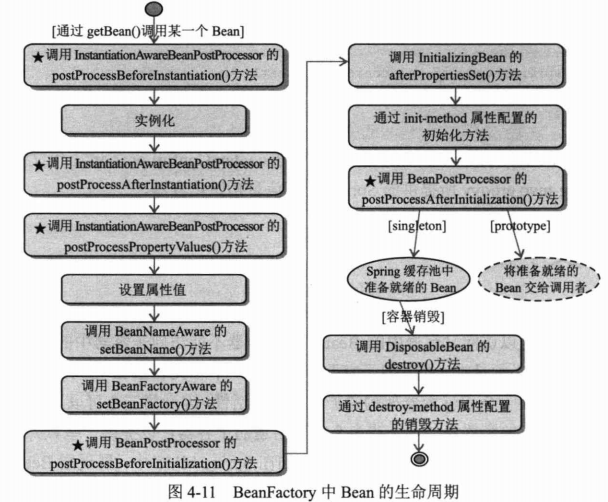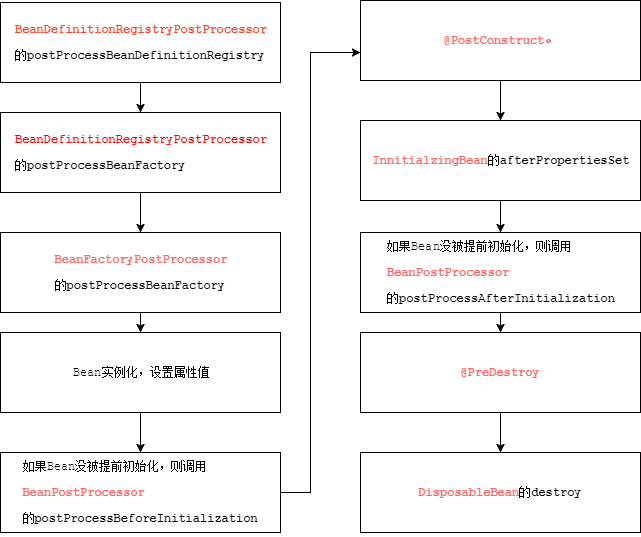先看一张图:spring4.x 企业实战
spring版本:4.3.17
1、bean自身的生命周期接口
1.1、实现 InitializingBean、DisposableBean 接口
这2个接口,会要求你实现2个方法
@Component
public class BeanSelf implements InitializingBean, DisposableBean {
@Override
public void afterPropertiesSet() throws Exception {
System.out.println("afterPropertiesSet");
}
@Override
public void destroy() throws Exception {
System.out.println("destroy");
}
}afterPropertieseSet 会在属性设置完毕,调用,这里的属性设置,指的是Bean的依赖注入。比如。在 BeanSelf中注入 BeanSelf2
private BeanSelf2 beanSelf2
@Autowired
public void setBeanSelf2(BeanSelf2 beanSelf2) {
System.out.println("注入BeanSelf2");
this.beanSelf2 = beanSelf2
}
运行结果
注入 beanSelf2
afterPropertiesSet
destroy1.2、使用 @PostConstruct、 @PreDestroy 注解
正如其名:在构造器之后, 即在销毁之前。
public class BeanSelf implements InitializingBean, DisposableBean{
private BeanSelf2 beanSelf2;
private BeanSelf3 beanSelf3;
public BeanSelf(BeanSelf2 beanSelf2) {
System.out.println("构造器注入 beanSelf2");
this.beanSelf2 = beanSelf2;
}
@Autowired
public void setBeanSelf3(BeanSelf3 beanSelf3) {
System.out.println("属性注入 beanSelf3");
this.beanSelf3 = beanSelf3;
}
@PostConstruct
public void init() {
System.out.println("PostConstruct");
}
@PreDestroy
public void initDestroy2() {
System.out.println("PreDestroy");
}
@Override
public void afterPropertiesSet() throws Exception {
System.out.println("afterPropertiesSet");
}
@Override
public void destroy() throws Exception {
System.out.println("destroy");
}
}运行效果
构造器注入 beanSelf2
属性注入 beanSelf3
PostConstruct --- 很明显 @PostConstruct 是在构造器之后注入 beanSelf2
afterPropertiesSet --- 在 PostConstruct 之后
PreDestroy --- 很明显,是在销毁之前调用的
destroy小总结:不管是@PostConstruct 或者 实现InitializingBean接口。 都是在Bean实例化完成之后才调用的。
2、beanFactory工厂接口,只调用一次
@Component
public class MyBeanFactory implements BeanFactoryPostProcessor {
@Override
public void postProcessBeanFactory(ConfigurableListableBeanFactory configurableListableBeanFactory) throws BeansException {
Iterator<String> iterator = configurableListableBeanFactory.getBeanNamesIterator();
BeanSelf2 beanSelf = (BeanSelf2) configurableListableBeanFactory.getBean("beanSelf2");
beanSelf.add();
System.out.println("beanFactoryPostProcessor");
}
}
@Component
public class BeanSelf2 implements InitializingBean{
public void add() {
System.out.println("add");
}
@Override
public void afterPropertiesSet() throws Exception {
System.out.println("beanSelf2 afterPropertiesSet");
}
}
这个接口的方法会在实例化之前调用。 在postProcessBeanFactory 中,对BeanSelf2提前进行初始化,并调用add方法。
beanSelf2 afterPropertiesSet -- 调用beanSelf2的afterPropertiesSet方法
add
beanFactoryPostProcessor
构造器注入 beanSelf2
属性注入 beanSelf3
PostConstruct
afterPropertiesSet
PreDestroyBeanFactoryPostProcessor 顾名思义,在这个方法里面可以拿到所有装载的Bean,并在初始化之前对某些Bean进行修改。(此时Bean还未初始化)
3、BeanPostProcessor接口在每个Bean实例之前,都会调用。如果Bean已实例化则不会diaoy
@Component
public class MyBeanPostProcessor implements BeanPostProcessor{
@Override
public Object postProcessBeforeInitialization(Object bean, String beanName) throws BeansException {
System.out.println(beanName +" = postProcessBeforeInitialization" );
if("beanSelf2".equals(beanName)) {
return null;
}
return bean;
}
@Override
public Object postProcessAfterInitialization(Object bean, String beanName) throws BeansException {
System.out.println(beanName +" = postProcessAfterInitialization");
return bean;
}
}上面这段代码的意思是,在初始化之前,将BeanSelf2 和 BeanSel3 置为null。但是,BeanSelf2不会走到这段代码内,因为在接口BeanFactoryPostProcessor 中,将BeanSelf2提前初始化了。所以输出结果如下
beanSelf2 afterPropertiesSet --- BeanFactoryPostProcessor中提前初始化
add --- 调用BeanSelf2的add方法
beanFactoryPostProcessor --- 在postProcessBeanFactory 中打印
beanConfig = postProcessBeforeInitialization --调用 BeanPostProcessor
beanConfig = postProcessAfterInitialization --调用 BeanPostProcessor
BeanSelf 构造器注入 beanSelf2 --BeanSelf 构造器注入属性
beanSelf3 = postProcessBeforeInitialization -- 在实例化之前调用
BeanSelf 属性注入 beanSelf3 -- 注入之前,BeanSelf3还没实例化,所以在之前调用 BeanPostProcessor
beanSelf = postProcessBeforeInitialization --- beanSelf 在属性设置完毕后,即初始化完毕 调用 BeanPostProcessor#postProcessBeforeInitialization()
BeanSelf PostConstruct -- 调用被 @PostConstruct 注解声明的方法
afterPropertiesSet -- 调用 InitializingBean 接口实现的方法
beanSelf = postProcessAfterInitialization
beanSelf2 com.xhn3.BeanSelf2@33cb5951
beanSelf3 null -- 在BeanPostProcessor中返回null。所以这边是null
BeanSelf PreDestroy
destroy小总结:BeanPostProcessor#postProcessBeforeInitialization在init-method之前调用,在属性设置完毕后调用。BeanPostProcessor#postProcessAfterInitialization 在InitializingBean#afterPropertiesSet后调用。
4、BeanDefinitionRegistryPostProcessor 注册Bean的接口,在BeanFactoryPostProcesso前调用
@Component
public class MyBeanRegister implements BeanDefinitionRegistryPostProcessor {
@Override
public void postProcessBeanDefinitionRegistry(BeanDefinitionRegistry registry) throws BeansException {
}
@Override
public void postProcessBeanFactory(ConfigurableListableBeanFactory beanFactory) throws BeansException {
}
}在该方法里面可以直接注册bean。可以提前实例化Bean
运行流程:

